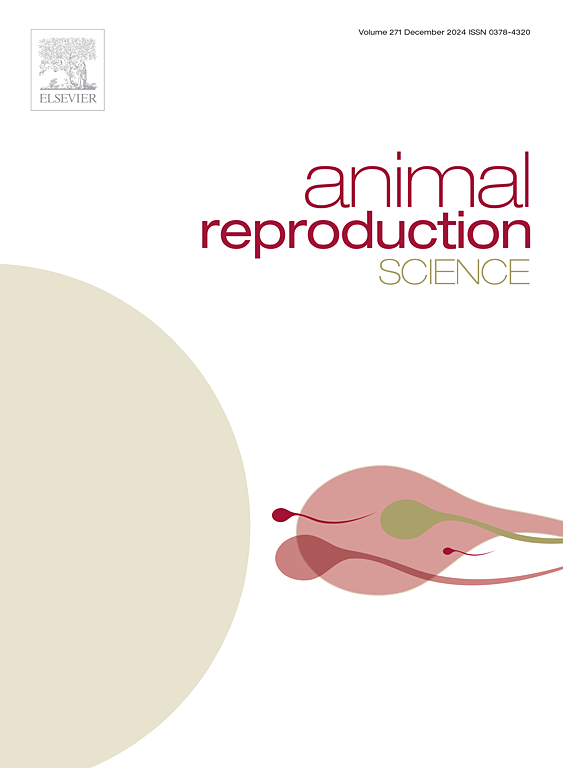Irisin modulates granulosa cell function in chicken ovarian follicles: Effects on viability, gene expression, and progesterone secretion
IF 3.3
2区 农林科学
Q1 AGRICULTURE, DAIRY & ANIMAL SCIENCE
引用次数: 0
Abstract
Irisin, a myokine/adipokine released during physical activity, has attracted attention for its regulatory effects on various physiological processes, including metabolism and reproduction. This study was performed to investigate the presence of fibronectin type III domain-containing protein 5 (FNDC5) in chicken granulosa cells (GCs) using immunocytochemistry and to assess the effect of irisin, the extracellular fragment of FNDC5, on these cells, which play a crucial role in progesterone (P4) production and follicle maturation. We measured cell viability, mRNA expression of the luteinising hormone receptor (LHR), the expression of steroidogenic genes (StAR, CYP11A1, and 3BHSD), and P4 secretion in GCs of chicken ovarian follicles. The results showed that irisin reduced the viability of all cultured GCs at different concentrations (0.5, 2.5, and 5 ng/mL). Real-time reverse transcription quantitative PCR demonstrated decreased expression of LHR and 3BHSD at 0.5 ng/mL irisin across GCs from preovulatory follicles of all stages (F3, F2 and F1), and elevated expression of StAR, 3BHSD, and LHR at 5 ng/mL in GCs from F1 follicles. Furthermore, irisin decreased P4 secretion from GCs isolated from F3 and F2 follicles, but increased the release of this hormone from F1 follicles at a 5 ng/mL concentration. These findings suggest that irisin may play a modulatory role in the maturation and ovulation of chicken ovarian follicles by influencing cell proliferation, gene expression, and hormone production depending on the dose and stage of follicle development.
鸢尾素调节鸡卵泡颗粒细胞功能:对活力、基因表达和黄体酮分泌的影响
鸢尾素是一种在运动过程中释放的肌肉因子/脂肪因子,因其对代谢和生殖等多种生理过程的调节作用而受到关注。本研究利用免疫细胞化学方法研究了鸡颗粒细胞(GCs)中纤维连接蛋白III型结构域蛋白5 (FNDC5)的存在,并评估了鸢尾素(FNDC5的细胞外片段)对这些细胞的影响,鸢尾素在孕酮(P4)的产生和卵泡成熟中起着至关重要的作用。我们测量了鸡卵泡GCs的细胞活力、促黄体生成素受体(LHR) mRNA表达、类固醇基因(StAR、CYP11A1和3BHSD)表达以及P4分泌。结果表明,鸢尾素在不同浓度(0.5、2.5和5 ng/mL)下均能降低培养的GCs的活力。实时反转录定量PCR结果显示,当鸢尾素浓度为0.5 ng/mL时,来自排卵前卵泡(F3、F2和F1)的GCs中LHR和3BHSD的表达降低,而当鸢尾素浓度为5 ng/mL时,来自F1卵泡的GCs中StAR、3BHSD和LHR的表达升高。此外,鸢尾素降低了从F3和F2卵泡分离的GCs的P4分泌,但在5 ng/mL浓度下增加了F1卵泡的P4释放。上述结果提示,鸢尾素可能通过影响卵泡细胞增殖、基因表达和激素分泌,根据剂量和卵泡发育阶段的不同,在鸡卵泡成熟和排卵中发挥调节作用。
本文章由计算机程序翻译,如有差异,请以英文原文为准。
求助全文
约1分钟内获得全文
求助全文
来源期刊

Animal Reproduction Science
农林科学-奶制品与动物科学
CiteScore
4.50
自引率
9.10%
发文量
136
审稿时长
54 days
期刊介绍:
Animal Reproduction Science publishes results from studies relating to reproduction and fertility in animals. This includes both fundamental research and applied studies, including management practices that increase our understanding of the biology and manipulation of reproduction. Manuscripts should go into depth in the mechanisms involved in the research reported, rather than a give a mere description of findings. The focus is on animals that are useful to humans including food- and fibre-producing; companion/recreational; captive; and endangered species including zoo animals, but excluding laboratory animals unless the results of the study provide new information that impacts the basic understanding of the biology or manipulation of reproduction.
The journal''s scope includes the study of reproductive physiology and endocrinology, reproductive cycles, natural and artificial control of reproduction, preservation and use of gametes and embryos, pregnancy and parturition, infertility and sterility, diagnostic and therapeutic techniques.
The Editorial Board of Animal Reproduction Science has decided not to publish papers in which there is an exclusive examination of the in vitro development of oocytes and embryos; however, there will be consideration of papers that include in vitro studies where the source of the oocytes and/or development of the embryos beyond the blastocyst stage is part of the experimental design.
 求助内容:
求助内容: 应助结果提醒方式:
应助结果提醒方式:


